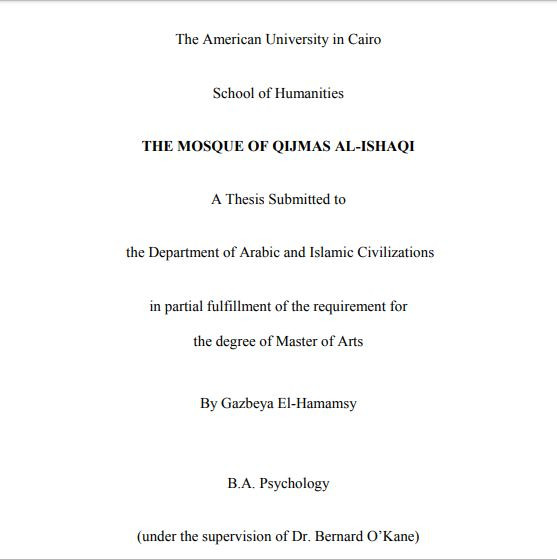
The subject of this thesis is the Burji Mamluk mosque of Qijmas al-Ishaqibuilt near the end of the fifteenth century during the reign of sultan Qaytbay. It wasfounded at a time when the city of Cairo had already become heavily built-up andwhen much maneuvering was needed in order to find a good spot in the city to buildon. Qijmas al-Ishaqi, being a powerful emir of sultan Qaytbay, managed throughseveral acts of istibdal to acquire the plot he wanted on al-Tabbana street in the Darbal-Ahmar area.At a time when the focus was on extensive decoration and not so mucharchitectural innovation, the mosque of Qijmas still managed to show ingenuity inboth its structure and its decoration. Most striking is the mosque’s staggered façadethat unfolds like a fan before the eyes of the passerby, and the bridge linking themosque to its dependencies on the other side of the street. The mosque did not onlyaccommodate the street contours, but it took complete charge of it, and fullyintegrated it into its plan. This in itself constituted an architectural feat given the oddtriangular plot the mosque was built on. The decoration of the mosque is bothinnovative and surprising at times. It does not simply conform to the Qaytbaydecorative repertoire but it displays its own decorative language, especially in itsmihrab, its portal and its extensive epigraphy.Also adding to the interesting aspect of the mosque were its oddities such asthe minaret and the dome, which were decorative misfits that appeared to have beenleft in an almost unfinished state. The kuttab lost its usual place above the sabil andwas moved altogether to the other side of the street from the mosque. In my research, I relied on a number of primary sources – most notably theComité bulletins and the waqfiyya of the mosque – and secondary sources. In mydiscussion on the restoration of the mosque, I conducted a close reading of the Comitébulletins, which provide a thorough documentation of the preservation works. Thewaqfiyya was important in clarifying the function of certain areas of the mosque,which may have otherwise been unclear to me.The mosque is a highly impressive architectural piece that relies heavily onthe element of surprise, with unexpected elements scattered throughout it. In manyways, it is an unusual building that not only followed the Qaytbay building style, butit altogether surpassed it.
El-Hamamsy, Gazbeya, ‘ The Mosque of Qijmas al-Ishaqi’ (Unpublished Master Thesis: The American University in Cairo, 2010).
I agree to the terms outlined below:
You agree to upload and assign Mosqpedia Database the rights to use the content worldwide and in perpetuity across all current and future media platforms. Mosqpedia Database may edit, copy, adapt and translate your contribution.
The content will be distributed under the Creative Commons Attribution-Deed – Attribution-NonCommercial-NoDerivatives 4.0 International – Creative Commons
All data will be stored in line with data protection regulations.